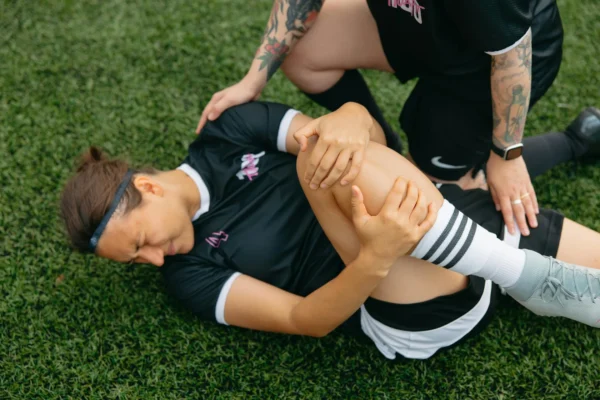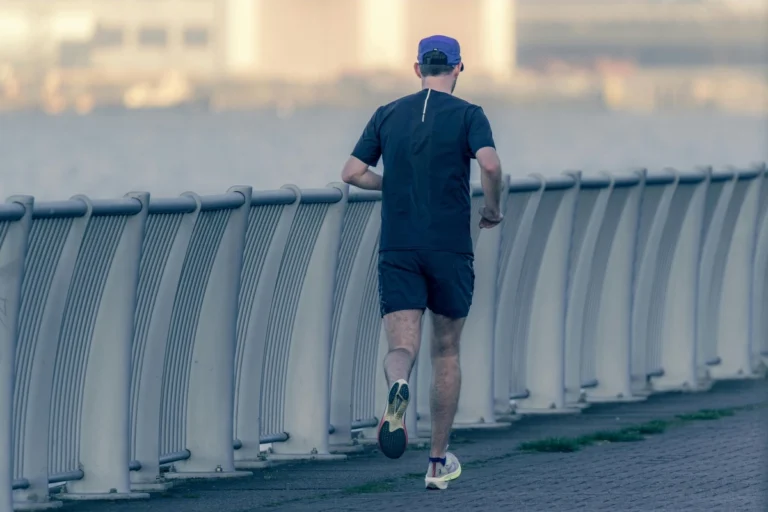Accredited Exercise Physiologists in Melbourne

10 Common Injuries in Female Soccer Players (and the Soccer Strength Exercises to Prevent Them)
If you’ve ever watched a teammate go down with a knee injury or spent weeks sidelined with a dodgy ankle, you already know that staying on the pitch isn’t just about skill – it’s about preparation. Female soccer players face unique injury risks, but here’s the good news: the right soccer strength exercises can dramatically reduce your chances of joining the injury list.
As exercise physiologists in Melbourne, we’ve worked with countless female footballers who’ve learned this lesson the hard way. This guide breaks down the 10 most common injuries in women’s football and, more importantly, the specific soccer strength exercises that’ll keep you playing the game you love.
Why Female Soccer Players Need Targeted Strength Training
Before we dive into specific injuries, let’s address the elephant in the room. Research consistently shows that female players experience certain injuries at significantly higher rates than their male counterparts. But this isn’t about being weaker – it’s about biomechanics, hormonal factors, and training gaps that exercise physiology can address.
The solution? Strategic soccer strength exercises that target your body’s specific vulnerabilities while enhancing performance. Let’s break down each injury and its prevention strategy.
1. ACL Tears: The Season-Ender
The Problem: Anterior cruciate ligament tears are 3-4 times more common in female players. These typically occur during rapid direction changes, pivoting, or landing from jumps with poor knee alignment.
Soccer Strength Exercises to Prevent It:
- Nordic hamstring curls: Build eccentric hamstring strength to control knee motion
- Single-leg Romanian deadlifts: Improve posterior chain strength and balance
- Lateral band walks: Strengthen hip abductors to prevent knee valgus (inward collapse)
- Box jumps with controlled landing: Train proper landing mechanics under load
Working with an exercise physiologist ensures these movements are progressed safely and effectively for your level.
2. Ankle Sprains: The Most Common Culprit
The Problem: Ankle sprains account for nearly 17% of all soccer injuries in female players, often occurring when planting, cutting, or landing awkwardly on uneven surfaces.
Soccer Strength Exercises to Prevent It:
- Single-leg balance progressions: Build ankle stability and proprioception
- Calf raises (straight and bent knee): Strengthen the muscles supporting your ankle
- Lateral hops: Improve dynamic ankle stability during direction changes
- Bosu ball exercises: Challenge ankle stabilisers in unstable conditions
3. Hamstring Strains: The Sprinter’s Nightmare
The Problem: Hamstring strains typically happen during high-speed running or when decelerating quickly – movements you do dozens of times per match.
Soccer Strength Exercises to Prevent It:
- Eccentric hamstring curls: The gold standard for hamstring injury prevention
- Glute-ham raises: Build strength through the entire posterior chain
- Slider leg curls: Develop hamstring strength in lengthened positions
- Sprint mechanics drills: Improve running technique to reduce strain
This is where exercise physiology Melbourne expertise really shines – proper load management prevents the injury-recovery-reinjury cycle.
4. Groin Strains: The Hidden Epidemic
The Problem: Groin injuries often develop gradually from repetitive kicking, quick lateral movements, and sudden direction changes without adequate hip strength.
Soccer Strength Exercises to Prevent It:
- Copenhagen adductor exercises: Specifically target groin strength
- Lateral lunges: Build strength through functional movement patterns
- Cable or band adduction: Isolate and strengthen inner thigh muscles
- 90/90 hip mobility work: Maintain hip range of motion to reduce compensation
5. Quadriceps Strains: The Explosive Power Tax
The Problem: Quad strains occur during explosive movements like shooting, jumping, or accelerating, particularly when muscles are fatigued.
Soccer Strength Exercises to Prevent It:
- Bulgarian split squats: Build unilateral quad strength and control
- Front squats: Develop quad strength with proper knee mechanics
- Box step-ups: Improve single-leg power and stability
- Isometric wall sits: Build muscular endurance for late-game fatigue resistance
6. Knee Contusions and Overuse Injuries
The Problem: Repetitive stress on knee structures from running, jumping, and contact can lead to patellofemoral pain, tendinopathy, or general knee soreness.
Soccer Strength Exercises to Prevent It:
- Terminal knee extensions: Strengthen the VMO for patellar tracking
- Step-downs with control: Build eccentric quad strength
- Leg press variations: Safely load the knee through full range
- Isometric holds at various angles: Build strength without aggravating symptoms
An exercise physiologist near you can assess your specific knee mechanics and prescribe targeted exercises.
7. Hip Flexor Strains: The Kicker’s Curse
The Problem: Hip flexor strains are common from repetitive kicking, sprinting, and rapid hip flexion movements, especially when core stability is lacking.
Soccer Strength Exercises to Prevent It:
- Dead bugs: Build core stability to reduce hip flexor compensation
- Resisted march variations: Strengthen hip flexors progressively
- Single-leg hip thrusts: Develop hip extension to balance flexion demands
- Pallof press: Improve rotational core stability for kicking mechanics
8. Shoulder and Collarbone Injuries: The Contact Risk
The Problem: Falls, collisions, and goal-diving can result in shoulder dislocations, AC joint sprains, or collarbone fractures.
Soccer Strength Exercises to Prevent It:
- Push-up variations: Build shoulder stability and strength
- Scapular retraction exercises: Improve shoulder blade control
- Rotator cuff strengthening: Protect the shoulder joint capsule
- Plank variations: Build upper body stability for impact absorption
While you can’t completely prevent contact injuries, stronger shoulders are more resilient shoulders.
9. Concussions: The Invisible Injury
The Problem: Female soccer players experience concussion rates similar to contact sports, from head-to-head collisions, elbows, or heading the ball.
Soccer Strength Exercises to Prevent It:
- Neck strengthening exercises: Build resistance to head acceleration
- Isometric neck holds (all directions): Improve cervical spine stability
- Upper trapezius strengthening: Support head and neck during impacts
- Proper heading technique drills: Reduce repetitive sub-concussive impacts
Note: While soccer strength exercises can’t eliminate concussion risk, neck strength has been shown to reduce severity and frequency.
10. Stress Fractures and Bone Injuries
The Problem: Repetitive loading without adequate recovery can lead to stress fractures, particularly in the metatarsals (foot), tibia (shin), or pelvis.
Soccer Strength Exercises to Prevent It:
- Progressive plyometrics: Build bone density safely
- Loaded carries: Improve skeletal strength through axial loading
- Calf raises and tibialis raises: Strengthen muscles supporting common fracture sites
- Gradual volume increases: Allow bone adaptation to training load
This is where exercise physiology knowledge becomes crucial – understanding the relationship between training load, recovery, and bone adaptation.
Building Your Prevention Program: The Exercise Physiologist Approach
Now that you understand the injuries and exercises, here’s how to structure an effective prevention program. As an exercise physiologist, we recommend this framework:
Pre-Season (6-8 weeks before season): Focus on building foundational strength and movement quality. This is when you can handle higher training loads without match demands competing for recovery.
In-Season (during competition): Maintain strength with 1-2 sessions weekly, focusing on key exercises for your individual risk factors. Quality over quantity is the name of the game.
Off-Season (post-season recovery): Address any imbalances or weaknesses identified during the season. Build a stronger base for the next campaign.
The Reality Check: Making Prevention Practical
Look, we get it. You’re already training with your team 2-3 times per week, playing matches on weekends, and juggling life commitments. Adding more seems impossible.
But here’s the thing: soccer strength exercises don’t need to take hours. A focused 30-45 minute session twice weekly can reduce your injury risk by up to 60%. That’s less time than you’d spend sidelined with even a minor injury.
Working with an exercise physiologist in Melbourne means getting a program that:
- Fits your schedule realistically
- Addresses your specific risk factors
- Progresses appropriately with your season demands
- Actually prevents injuries rather than ticking boxes
Common Questions About Soccer Strength Exercises
“Won’t weights make me slower or bulky?” Absolutely not. Properly designed soccer strength exercises improve power, speed, and agility. You’re building functional strength, not bodybuilding.
“Can I just do these exercises at home?” Some, yes. Others require specific equipment or coaching to ensure proper technique. An exercise physiologist near you can show you what’s safe to do independently versus what needs supervision.
“How quickly will I see results?” Movement quality improvements happen within weeks. Significant strength gains and injury risk reduction typically show within 6-8 weeks of consistent training.
Your Action Plan: From Knowledge to Prevention
Understanding these 10 common injuries and their prevention strategies is step one. Step two is implementing soccer strength exercises that actually work for your body, your position, and your schedule.
Here’s what your initial assessment with our exercise physiology Melbourne team includes:
- Comprehensive movement screening to identify your specific risk factors
- Strength testing to establish baselines and track progress
- Personalised program featuring the most important soccer strength exercises for you
- Progression plan that evolves with your season demands
- Ongoing support to keep you consistent and injury-free
Don’t Wait for Injury to Force Your Hand
Every weekend, talented female footballers sit on the sidelines watching teammates play, wishing they’d taken prevention seriously. Don’t let that be you next season.
The best time to start injury prevention was before your last season. The second-best time is right now. Get in touch.
Searching for an exercise physiologist who actually understands female soccer demands? Our exercise physiologists in Melbourne specialise in injury prevention and performance enhancement for footballers at all levels.

